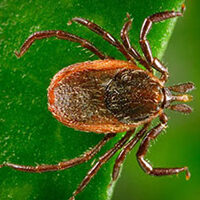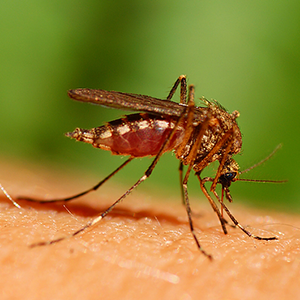Contact Us
Overview
Lyme disease is a bacterial disease transmitted to animals and humans by the bite of certain ticks infected with the bacterium Borrelia burgdorferi. Symptoms include a bullseye-shaped rash, fatigue, headache and fever.
Basics

Lyme disease, or borreliosis, is caused by the bacterium Borrelia burgdorferi. This disease is transmitted to animals and humans by blacklegged ticks (image right), also known as deer ticks, infected with the bacteria. Blacklegged ticks are not native to the Spokane area and do not live in Spokane County. Studies show a tick must be attached for 36 to 48 hours or more to give the disease to its host. Most cases of Lyme disease are caused by young ticks called nymphs because they are small—less than 2 millimeters—and hard to see.

The only type of blacklegged ticks found in Washington state are western blacklegged ticks (image left), which live in forested, brushy areas in parts of western Washington—blacklegged and western blacklegged ticks are not present in Spokane. Other kinds of blacklegged tick live in the northeastern and upper midwestern United States, where the majority of Lyme disease cases are reported.
Symptoms of infection begin with fever, headache, fatigue and a distinct, sometimes bullseye-shaped skin rash called erythema migrans. As the infection continues, other parts of the body can be affected, including the joints, heart and nervous system.
Lyme disease is diagnosed based on symptoms, laboratory testing, the presence of a rash (see below) and the possibility of exposure to ticks. Symptoms are divided into early- or late-stage disease, dependent on severity and length of time person has been infected.

Erythema Migrans Rash An erythema migrans rash occurs in 70 – 80 percent of infected people. The rash appears at the bite site after about seven days, although it can occur at any time between three and 30 days. The rash expands over time and can be up to 12 inches across. As it enlarges, it may clear, causing a characteristic “bullseye” shape on the skin. While the rash may feel warm to the touch, it’s rarely painful.
Diagnosis
Lyme disease is diagnosed based on a patient’s symptoms and their history of possible exposure to infected blacklegged ticks. For patients with standard Lyme disease symptoms, laboratory blood tests may also be useful.
Treatment
When caught early enough, cases of early-stage Lyme disease can be treated with antibiotics and patients can expect a full recovery.
Post-Treatment Lyme Disease Syndrome
Post-Treatment Lyme Disease Syndrome is condition in which a patient has received full antibiotic treatment for Lyme disease but still has symptoms, even though tests show that the bacteria is gone. Symptoms include pain and joint and muscle aches. Researchers have not determined a cause for this syndrome.
Sources
Transmission | CDC | https://www.cdc.gov/lyme/trans...
Ticks | Washington State DOH | https://www.doh.wa.gov/Communi...
Blacklegged Tick | CDC | https://www.cdc.gov/ticks/tick...
Signs and Symptoms of Untreated Lyme Disease | CDC | https://www.cdc.gov/lyme/signs...
Diagnosis and Testing | CDC | https://www.cdc.gov/lyme/diagn...
Treatment | CDC | https://www.cdc.gov/lyme/treat...
Post-Treatment Lyme Disease Syndrome | CDC | https://www.cdc.gov/lyme/postl...
Recommendations
The best way to avoid getting Lyme disease is to avoid getting bitten by a blacklegged tick. There are things people can do to reduce the likelihood of a bite. By avoiding ticks, people can reduce their exposure to Lyme and other diseases spread by ticks. Learn more about ticks and best practices for avoiding them.
Ticks are most active in warmer months, so it’s especially important to be vigilant during those times. Ticks position themselves in brush and grasses, holding on with their back legs while reaching out with their front legs, waiting to grab onto passing people or animals. Once they grab on, they crawl to a feeding spot on the host’s body and bury their mouthparts into the skin to eat blood. Learn more about ticks here.
Related Facts
Blacklegged ticks are not native to the Spokane area and do not live in Eastern Washington.
In Washington, 0 – 3 cases of Lyme disease are reported each year.

Bring It, Summer Pests!
Confront disease-carrying mosquitoes, ticks and mice during spring and summer months. Simple landscaping tricks and tips to protect home’s exterior.

Animals & Insects Program
Preventing the spread of disease from animals to humans is a public health responsibility.
